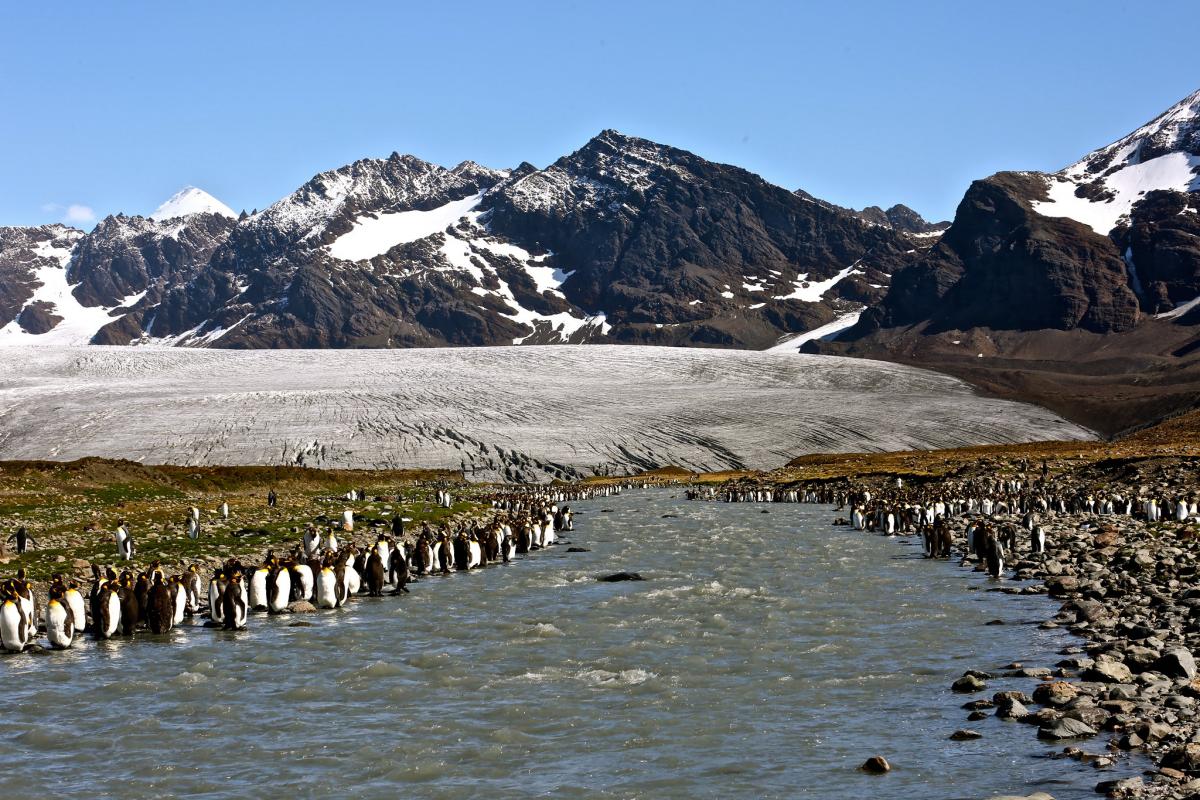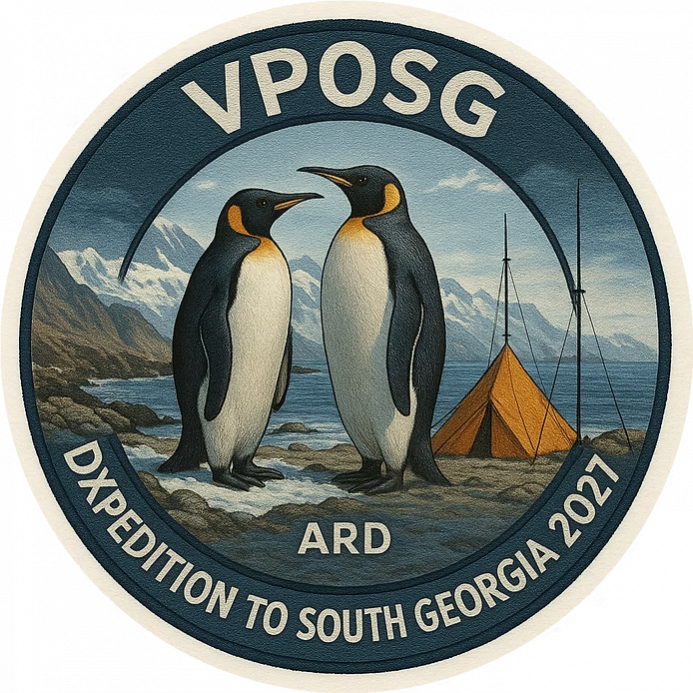VP0SG Team will be active from South Georgia Island, IOTA AN - 009, during March 2027.
Team - Members of the Amateur Radio DX Peditions.
Recent DX Spots VP0SG
VP0SG Log search They will operate on HF Bands.
QSL via M0OXO, OQRS, LOTW.
More information soon:
VP0SG News 23 May 2025
Amateur Radio DXpeditions (ARD) is proud to announce plans for a groundbreaking DXpedition to South Georgia Island, set to take place in March 2027.
Operating under the allocated callsign VP0SG, this ambitious activation will target one of the rarest and most logistically challenging DXCC entities, well ranked on top of the ClubLog’s Most Wanted List, with particularly high demand in some areas of the world.
The remote sub-Antarctic island of South Georgia poses access difficulties due to its protected environmental status, mountainous terrain, and volatile weather conditions. After extensive negotiations and ongoing permitting discussions with the Government of South Georgia & the South Sandwich Islands (GSGSSI), ARD is optimistic about securing authorization for an onshore operation.
The team has reserved a rugged, ice-strengthened expedition motor vessel known for its support of polar science missions for the period of the DXpedition to South Georgia. The ship's versatility and compact size make it an ideal platform for staging low-impact landings and providing continuous logistical support to the operator team.
“Our goal is to deliver a world-class, environmentally responsible DXpedition with global reach” said Rune LA7THA, one of the ARD leadership team. “This project combines technical innovation, strategic planning, and a strong commitment to youth mentorship.”
As a project that aligns closely with the values of international amateur radio collaboration, education, and high-impact DXing, ARD is currently seeking sponsorship and support from key organizations in the amateur radio community to bring VP0SG to life.
South Georgia is a small territory of England among the ice of Antarctica
South Georgia is a large island that is part of the archipelago of the same name. Territorially, it belongs to the overseas territories of Great Britain. This piece of land is located southeast of the Falkland Islands, whose governor administers this and other islands in the area.
South Georgia is surrounded by the Pacific Ocean and the Scotia Sea to the southwest.
From sailors to armed conflicts – pages from the island's history
Many modern historians claim that the island was discovered by James Cook. But this is not entirely true. It was first stumbled upon by accident by an English merchant named Anthony Roche. He was sailing from Chile, hoping to reach Brazil. Near Cape Horn, the ship was caught in a severe storm and was blown far to the east. It was there that the sailors saw a large island with a bay that would provide shelter from the weather. They stayed there for a couple of weeks. On maps, this piece of land was marked as Roch Island.
Then the Spanish stumbled upon this territory. The crew of the ship Leon named it San Pedro.
But the first person to explore South Georgia in detail was Cook. He mapped this piece of land and named it after his own king, George. This navigator officially declared that the island belonged to Great Britain.
In the 20th century, this territory became a famous center for whalers. Several bases for this industry were established on the island.
It was during this period that Grytviken, the island's only settlement today, was established. The popularity of whaling contributed to the intensive development of villages on South Georgia until 1965.
In 1955, Argentina began to claim the island. Numerous legal proceedings ensued. Along with claims to the Falkland Islands, this led to armed conflict.
In 1982, Argentine troops landed on South Georgia. After a brief battle, the British garrison surrendered. The armed forces then recaptured the island.
After that, an army garrison was stationed in Grytviken until 2001. Then it left the island. Today, this piece of land is administered by a civilian administration.
 South Georgia Island. Author - Margarita Cabre.
South Georgia Island. Author - Margarita Cabre.
Climate, fauna, and flora of South Georgia
The island is located in the subarctic climate zone. In winter, the temperature on the island ranges from –2 °C to +5–6 °C in summer. Precipitation is evenly distributed throughout the year.
It usually falls as snowflakes or light sleet. Strong winds are also prevalent, contributing to stormy weather. South Georgia is usually cloudy. Low cloud cover is also characteristic of this location.
This patch of land has meadows and tundra with sparse vegetation (usually lichens and mosses). Permanent glaciers are found in the mountains in the center of the island and in the coastal zone.
The island's fauna is quite rich. The coast is inhabited by many birds, including several species of penguins. Albatrosses are also found here. It is believed that about 80% of these birds nest here. Huge rookeries of fur seals and seals can be found in the coastal zone.
 VP0SG South Georgia Island DX Pedition Logo.
VP0SG South Georgia Island DX Pedition Logo.
Population and other characteristics of South Georgia
There is no permanent population that has lived on the island for many generations. Today, there are about a hundred fishermen, scientists engaged in Antarctic research, and meteorologists. The number of people fluctuates constantly depending on the season. They live in weather stations and separate dwellings.
This situation is due to the harsh climatic conditions of South Georgia. The island's administration is located in Grytviken, which usually has a population of no more than 30 people.
At the beginning of the 20th century, deer were brought here. Over the following years, they became feral and continued to breed actively. As a result, the island's ecology was threatened, as the vegetation in the tundra was completely eaten away. In 2012, the UK was forced to bring in Norwegian professional hunters to shoot more than 3,000 of these feral animals.
Today, tourists visit the island, but their numbers are small. Foreigners are primarily interested in the whaling stations, which are currently being restored, the island's museum, and the grave of Ernest Shackleton, an explorer who dedicated his life to studying Antarctica.
Extreme sports enthusiasts who love unusual conditions for spending their free time periodically come here. They reach the island on ships adapted for sailing in the Antarctic zone or fly in from the mainland by helicopter, as there is a landing pad for such aircraft in Grytviken.
Only a few British companies offer such tours. Other travel agencies specializing in travel are not interested in this destination.
Interestingly, the island has no fauna of its own. However, gray rats, which escaped from ships, and even descendants of domestic cats have thrived in South Georgia.
But what is most interesting to scientists is the underwater ocean world, which is abundant in the coastal waters. Here they observe many species of mollusks, echinoderms, as well as giant jellyfish typical of Antarctica, some of which can weigh from 100 to 150 kilograms. Researchers are studying krill in particular depth. This planktonic crustacean has a wide range in Antarctica and is of great interest to modern science.
The number of baleen whales, which were considered the main consumers of these crustaceans, has significantly decreased. This has made it easier to observe them, especially since krill is considered a valuable source of protein.
Scientists are also studying elephant seals that come to the island to mate and give birth to their young. Despite their enormous size, these animals are not particularly aggressive. Much more dangerous are the sea lions that also live on South Georgia. They move much faster on land. These ocean dwellers have repeatedly attacked people, growling like dogs. But if you don't approach them, there is no danger.
Today, South Georgia is a land with a very harsh climate, where only strong people or true scientists can live.

